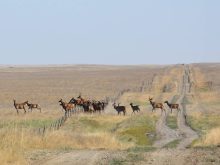Reports that a case of Cache Valley Virus has been recently found in a Saskatchewan sheep flock are unconfirmed, according to the Saskatchewan agriculture department.
The virus, spread by biting insects, causes early term abortion and defects in lamb fetuses, as well as malformed lambs in those that make it to term.
The ministry said a sample has been sent for testing to confirm whether CVV is present in a Saskatchewan flock.
“We are optimistic it is not CVV as the disease is spread by biting insects and doesn’t cause birth defects until after 36 days of gestation,” the department said in response to Western Producer queries.
Read Also

Crop quality looks good this year across Prairies
Crop quality looks real good this year, with the exception of durum.
“In this case, exposure would have had to occur after the middle of September. Other possibilities include (but are not limited to) border disease virus or toxin exposure.
Cache Valley Virus is not a reportable disease in Canada. It takes its name from Cache Valley in Utah where it was first isolated in mosquitoes. There is no vaccine or treatment.
However, it does circulate in Canada and the United States. A June 2019 article in Sheep Sense, a publication by the Manitoba Sheep Association, said CVV mostly affects the brain and central nervous system of affected lambs, as well as the skeletal system where it manifests in curved or twisted spines, thin and underdeveloped muscles and enlarged skulls.
Given the seasonality related to mosquitoes in Canada, lambs born in late winter and early spring are most likely to be affected if CVV is a factor.
The University of Guelph published a paper on the virus, which caused an outbreak of congenital lamb malformations in Ontario in late 2015 and early 2016.
“Late summer and early autumn are the months when the highest amount of virus is present in the mosquito population,” Guelph researchers reported.
“CVV is considered endemic in most parts of the United States, Mexico and Canada and infects a wide range of domestic and wild animals, as well as humans. Since 2010, a new strain of CVV originating in Mexico has emerged and is now the dominant lineage in the northeastern U.S.”
Once infected, ewes develop immunity. The virus is a threat only in the early stages of gestation, so the best protection is to limit ewe exposure to mosquito-infested areas during and shortly after the breeding season.
“Animals in Saskatchewan are widely exposed to Cache Valley Virus. Because it is mosquito-borne, and when breeding typically occurs, it is unlikely to see clinical effects on lambs unless early lambing,” Saskatchewan Agriculture said.
Contact barb.glen@producer.com


















